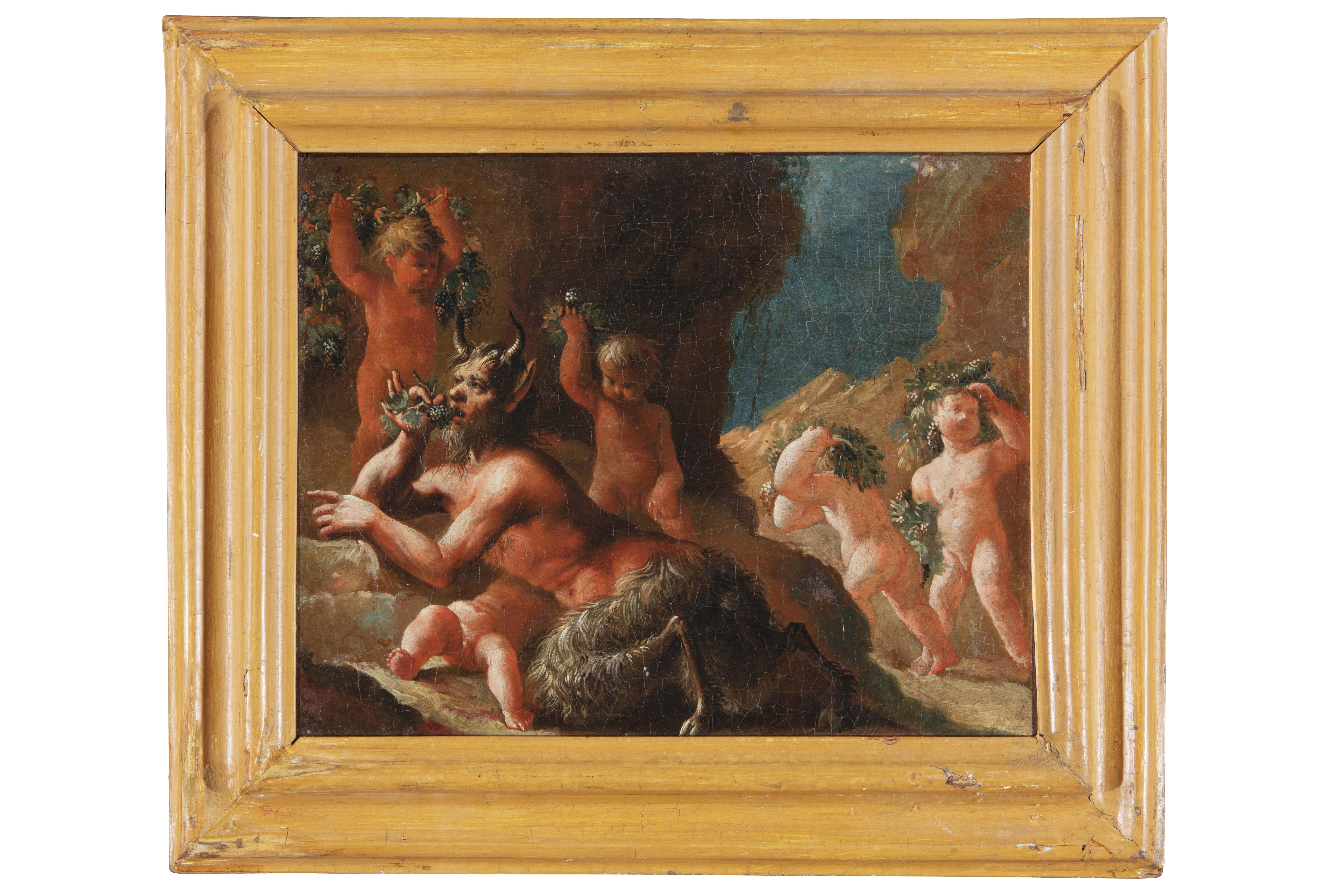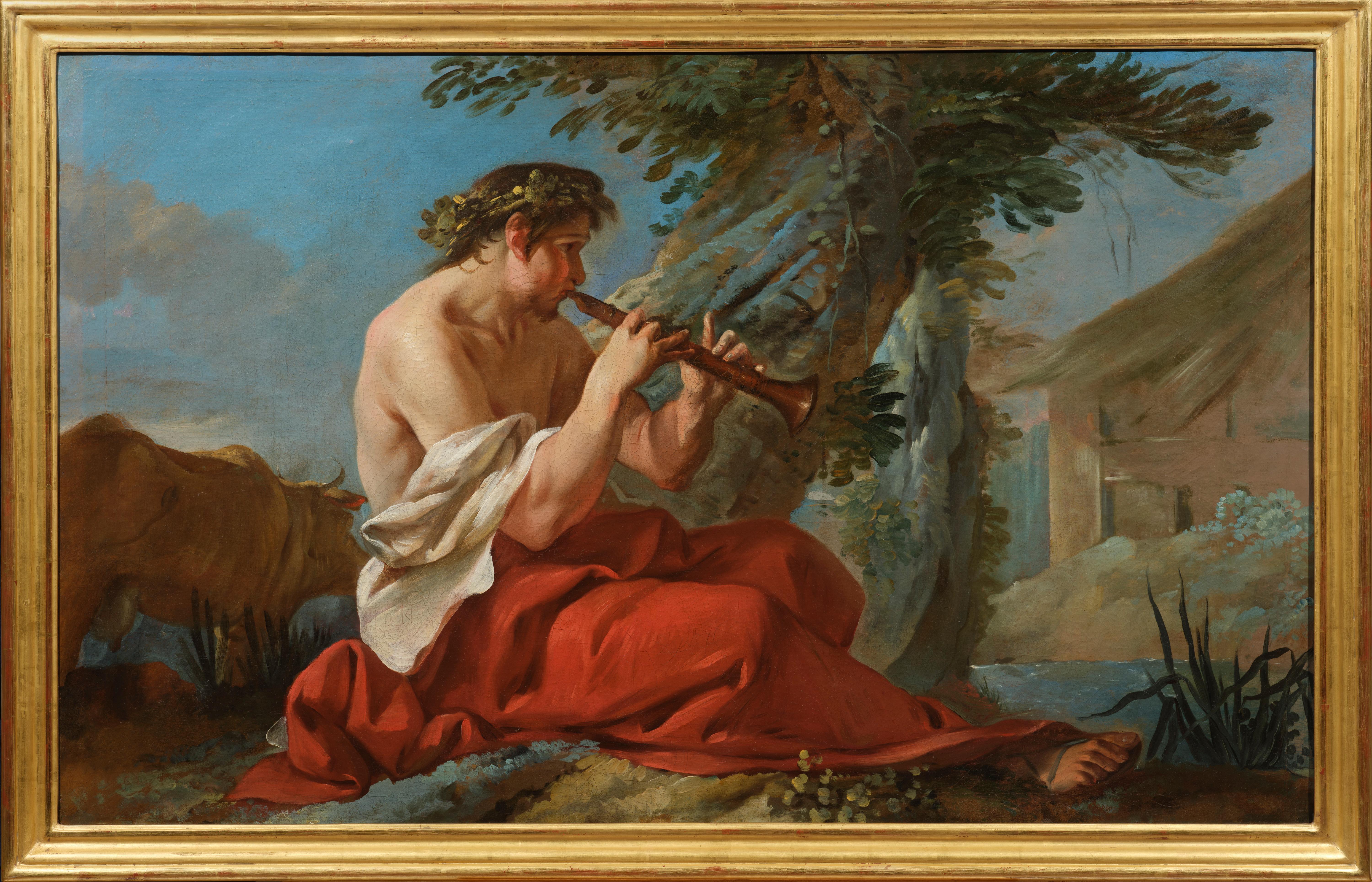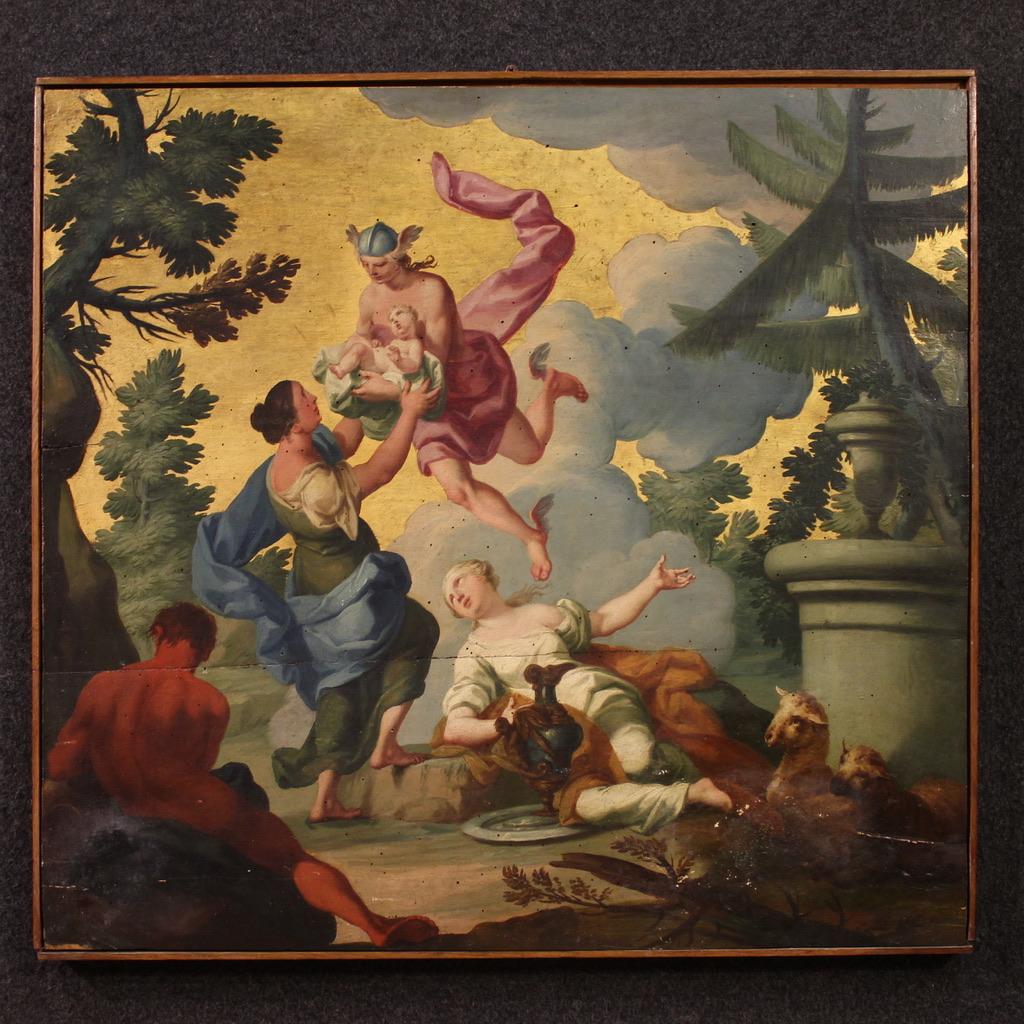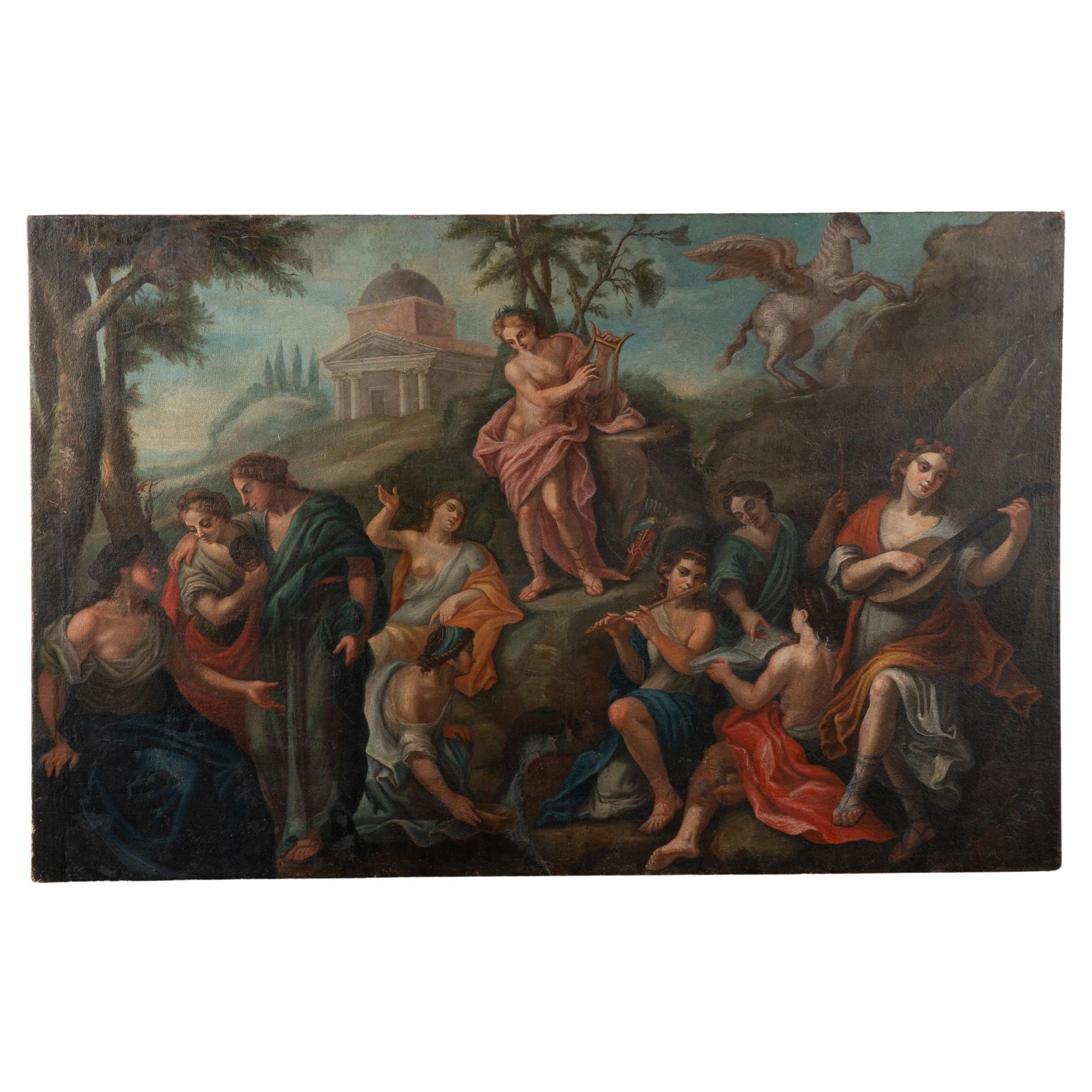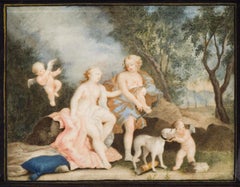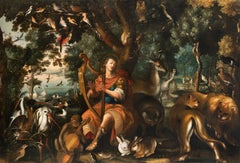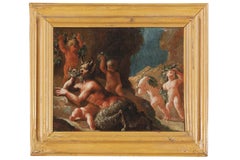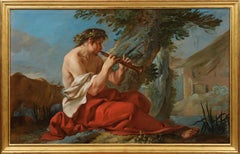Items Similar to Orpheus - Original Oil on Canvas Attr. to Tommaso Salini - Early 17th Century
Want more images or videos?
Request additional images or videos from the seller
1 of 5
Tommaso SaliniOrpheus - Original Oil on Canvas Attr. to Tommaso Salini - Early 17th CenturyEarly 17th Century
Early 17th Century
$17,460.70
£12,918.74
€14,500
CA$24,142.53
A$26,505.48
CHF 13,827.97
MX$320,753.26
NOK 173,312.11
SEK 163,305.58
DKK 110,403.41
About the Item
Orpheus is an original artwork realized in the first decades of the XVII century and attributed to the Italian master Tommaso Salini.
Oil painting on canvas.
A golden wood frame is included (25.5 x 31.2 cm).
Mint conditions.
Precious and top notch painting representing the classical myth of Orpheus with the standard iconography. This small yet magnificent oil on canvas is a fine exemple of Roman painting during the Baroque period. According to ancient mythology, Orpheus is usually represented holding a lyre and surrounded by different animals. Another iconographic attribute is the laurel oak. These iconographic symbols make him similar to the figure of Apollo. According to mythology, Apollo gave Orpheus his first lyre. Orpheus’s singing and playing were so beautiful that animals, trees and even rocks moved around him to dance. Orpheus was a legendary musician and poet of Thracian origins. He is one of the most significant figures of classical mythology and, in Western culture, his figure relates to different forms of art and music. This legendary hero, indeed, was born with supernatural musical and artistic skills. Traditionally, Orpheus was the son of the Muse Calliope, symbol of epic poetry, and Oegrus, king of Thrace. In this small artwork, the figure of Orpheus is represented with his most important features in a late-Mannerism composition and setting.
This artwork can be attributed to Tommaso Salini (Rome, 1575 - 1625), an Italian master of the Baroque period, active in Rome. The artist specialized in genre scene and in still life paintings. Two more paintings with sacred subject matters have been attributed to him: the San Nicola da Tolentino and the Santi Quattro Coronati. The former is currently preserved in Rome, in the church of St. Agostino. The artist was influenced by the works of Caravaggio.
This artwork is shipped from Italy. Under existing legislation, any artwork in Italy created over 70 years ago by an artist who has died requires a licence for export regardless of the work’s market price. The shipping may require additional handling days to require the licence according to the final destination of the artwork.
- Creator:Tommaso Salini (1575 - 1625, Italian)
- Creation Year:Early 17th Century
- Dimensions:Height: 10.04 in (25.5 cm)Width: 12.29 in (31.2 cm)Depth: 0.99 in (2.5 cm)
- Medium:
- Movement & Style:
- Period:Early 17th Century
- Condition:Insurance may be requested by customers as additional service, contact us for more information.
- Gallery Location:Roma, IT
- Reference Number:Seller: M-1008191stDibs: LU65034414501
About the Seller
4.9
Platinum Seller
Premium sellers with a 4.7+ rating and 24-hour response times
1stDibs seller since 2017
7,709 sales on 1stDibs
Typical response time: 2 hours
- ShippingRetrieving quote...Shipping from: Roma, Italy
- Return Policy
Authenticity Guarantee
In the unlikely event there’s an issue with an item’s authenticity, contact us within 1 year for a full refund. DetailsMoney-Back Guarantee
If your item is not as described, is damaged in transit, or does not arrive, contact us within 7 days for a full refund. Details24-Hour Cancellation
You have a 24-hour grace period in which to reconsider your purchase, with no questions asked.Vetted Professional Sellers
Our world-class sellers must adhere to strict standards for service and quality, maintaining the integrity of our listings.Price-Match Guarantee
If you find that a seller listed the same item for a lower price elsewhere, we’ll match it.Trusted Global Delivery
Our best-in-class carrier network provides specialized shipping options worldwide, including custom delivery.More From This Seller
View AllMythological Scene - Oil on Board - 18th Century
Located in Roma, IT
Mythological Scene is a mixed colored painting on board realized by Anonymous artist in the XVIII century.
The artwork represents a mythological scene with women and cherubs.
Inclu...
Category
18th Century Figurative Paintings
Materials
Board, Oil
Bucolic Scene - Oil on Canvas Attributed to Michelangelo Ricciolini - 1705
By Michelangelo Ricciolini
Located in Roma, IT
Bucolic Scene is a majestic oil painting on canvas attributed to the painter Michelangelo Ricciolini.
Includes a frame: 142 x 173 cm.
Good conditions, except for little loss of color on the canvas.
The beautiful painting represents a bucolic scene where shepherds, women, and children are conversing in a resting moment. The scene is set in an open space, probably a wood.
Michelangelo Ricciolini (1654 – 1715) was an Italian painter of the Baroque period. He first studied in Rome under Angelo Canini; he then joined the large studio of Carlo Maratta. He painted various works in Rome, including the dome of Santa Rita...
Category
Early 1700s Figurative Paintings
Materials
Oil
Hercules and Omphale - Oil Painting on Canvas - 18th Century
Located in Roma, IT
Hercules and Omphale is an original painting realized in France between the end of the 18th and the beginning of the 19th Century.
Original oil painting on canvas. Dimensions: 73 x...
Category
Late 18th Century Modern Figurative Paintings
Materials
Canvas, Oil
Landscape with Figures and Herd - Original Oil On Canvas - 18th Century
Located in Roma, IT
Landscape with figures and herd is an original oil on canvas realized in the 18th Century by a School Master of Central Italian School.
Original oil painting on Canvas.
The painti...
Category
18th Century Modern Landscape Paintings
Materials
Canvas, Oil
Landscape with Merchants Arranging the Goods - Oil Paint - Late 17th Century
Located in Roma, IT
Oil on canvas attributed to Philipp Peter Roos Rosa da Tivoli, realized in the late 17th Century in Italy.
Large work with very fine workmanship, in particular in the creation of an...
Category
Late 17th Century Baroque Figurative Paintings
Materials
Oil
Agar and the Angel -Oil Paint - Late 17th Century
Located in Roma, IT
Oil on canvas realized in Italy ih the late 17th Century.
The painting depicts the episode from Genesis (21, 9-21) in which the servant Hagar, together woth her little son Ishmael b...
Category
Late 17th Century Baroque Figurative Paintings
Materials
Oil
You May Also Like
Flemish 17th, Orpheus and Animals, Large Decorative Wall Old Master Painting
Located in Greven, DE
Flemish school, 17th century
Orpheus and the animals
Oil on canvas, 146,5 x 217 cm
Provenance: South German private collection.
On an impressive, room-filling format, this painting depicts "Orpheus and the Animals."
The harp-playing Orpheus sits centrally in front of a tree whose trunk bifurcates above his head. This central tree frames with its crown the scenery towards the horizon and at the same time offers through branches the possibility for many birds to find space. The left half of the picture is characterized by a seascape, at the edge of which the ruins of a castle can be seen deep in the background. This seascape, framed by mountains on the horizon, is the only area where sky can be seen. On this side, waterfowl such as storks, swans and ducks can be seen. In the right half, the viewer looks into a deep European forest. On this right side, more land animals can be found, such as deer, rabbits and lions, among others. Orpheus wears opulent red and gold trimmed clothing, under his blue breastplate we see a white shirt. His feet are adorned by elaborate sandals. His head is surrounded by a radiant laurel wreath ("poeta laureatus"). The young man is clearly identifiable as the singer and poet of Greek mythology, Orpheus, by his harp, the laurel wreath and the animals surrounding him.
Orpheus was one of the Argonauts who, under Jason, was searching for the Golden Fleece. He sang so beautifully that he even conquered the angry sea and enemies by the magic of his lyre. During the journey, Orpheus is said to have drowned out even the sirens with his singing. It is said that he was the greatest of all poets and charmed people, animals, stones and trees with his singing.
In total, 51 birds and 37 different species are depicted in the painting. The animals are mostly depicted in great detail and, except for a few, can be identified. Mainly European species of animals are shown. Exceptions are the ostrich-like nandu peeking out from behind the deer, as well as the large parrot on the upper left, and the two lions. Similar is the case for the large animal directly behind Orpheus on the right. The shape of the head suggests an arctic fox from the polar regions, even though the body is much too large. The arctic fox was first described in 1555 by Olaus Magnus. However, it could also be a depiction of a brown or black bear.
An unusual detail is the animal, which is relatively isolated in the right background and looks to the left. It is not clearly identifiable, but it shows certain similarities with the Australian kangaroo. This was first described by Vespucci in 1500 and further by Francisco Pelsaert in 1629. If it is indeed a kangaroo, this would be one of the earliest surviving pictorial representations.
In this painting, Orpheus is accompanied by a small monkey playing a viola da gamba. This is an iconographic peculiarity. In general, this painting has some peculiarities compared to other paintings with "Orpheus and the animals". The central positioning of Orpheus is quite common, but he usually holds a lyre and is dressed in an antique style, but not as opulently. The choice of animals is also remarkable: European animals in particular are seen, hardly any exotic features, such as camels or elephants.
The two lions in the right foreground are a quotation from Peter Paul Rubens and his depiction of "Daniel in the Lion's Den", which was realized in an engraving.
The present painting can be classified as belonging to the Flemish School of the 17th century on the basis of its painterly and compositional conception. From the circle of Jan Brueghel the Younger are numerous representations of this Orpheus - theme, which take it as an opportunity to show as many exotic animals. There are also echoes of Spanish painters such as Juan de Arellano...
Category
17th Century Baroque Landscape Paintings
Materials
Canvas, Oil
18th century By French Maestro Bacchanal Oil on canvas
Located in Milano, Lombardia
18th Century French Maestro
Title: Bacchanal
Medium: Oil on canvas
Dimensions: without frame 24 x 30 cm - with frame 33.5 x 39 cm
Antique shaped wooden frame lacquered in mustard col...
Category
18th Century Old Masters Figurative Paintings
Materials
Oil, Canvas
$10,789 Sale Price
20% Off
Mercury and Io, a rediscovered painting by Jean-Baptiste Marie Pierre (ca. 1740)
Located in PARIS, FR
We would like to thank Mr. Nicolas Lesur for confirming the autograph nature of the entire composition after a direct examination of the painting on November 27, 2024.
This painting...
Category
1740s Old Masters Figurative Paintings
Materials
Canvas, Oil
Diana Boullogne Mythological Paint Oil on canvas old master 17/18th Century
Located in Riva del Garda, IT
Bon Boullogne (Paris, 1649 - Paris, 1717) workshop of
Episodes from the myth of Diana
oil painting on canvas
Dimensions: 84 x 114 cm.
with antique frame 100 x 132 cm.
The beautiful painting proposed shows a series of episodes taken from the myth of the divinity Diana, the Roman divinity of hunting, forests and wild animals, masterfully captured in this valuable painting, which shows a luxuriant wood, a favorite place of the divinity, as a theater of his adventures.
The composition opens, on the left, with a sort of presentation of the divinity, portrayed as an attractive young girl, surrounded by her faithful Nymphs, one of whom holds her quiver with arrows, and by one of her beloved dogs. hunting her.
The 'story' continues in the central part where we can see the divinity during a wild boar hunt...
Category
Late 17th Century Old Masters Paintings
Materials
Oil
$8,516 Sale Price
20% Off
18th Century Oil on Panel Italian Mythological Painting, 1760
Located in Vicoforte, IT
A rare 18th-century Italian painting. Oil on panel artwork depicting a captivating mythological subject, Mercury delivers the infant Bacchus to the Nymphs of Mount Nysa. According to...
Category
1760s Figurative Paintings
Materials
Oil, Wood
Original Oil On Canvas Large Allegorical Painting, Italian School 1750-1800
Located in Round Top, TX
Original large oil on canvas allegorical scene from Italy with vivid colors. Note the Pegasus, ten figures, and use of lute, lyre and flute.
Condition: Age related craquelure throug...
Category
Antique 18th Century Italian Paintings
Materials
Canvas, Wood, Paint

